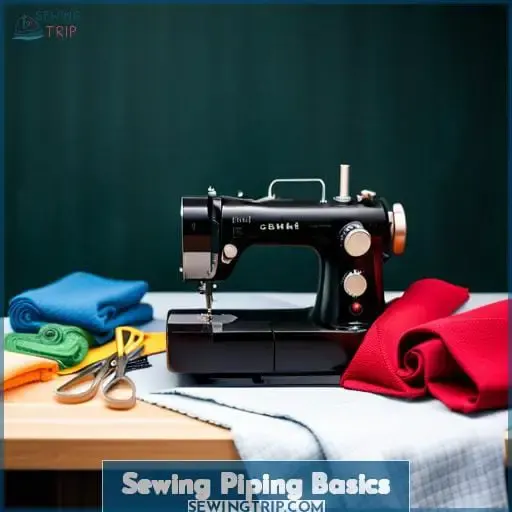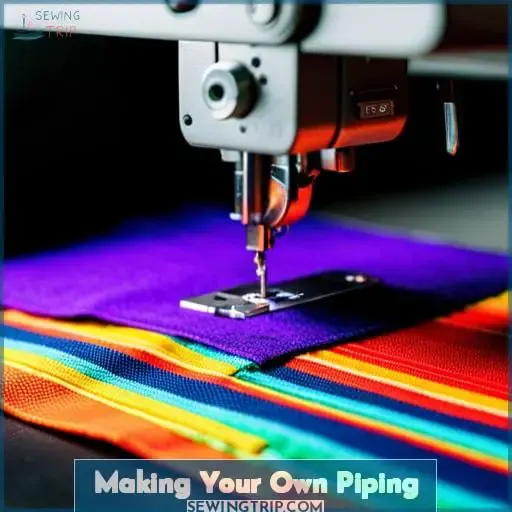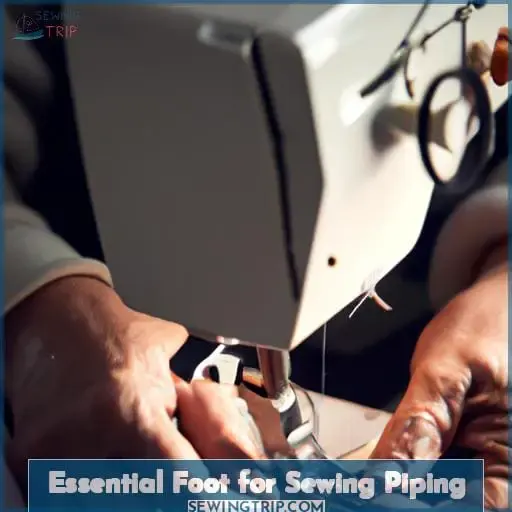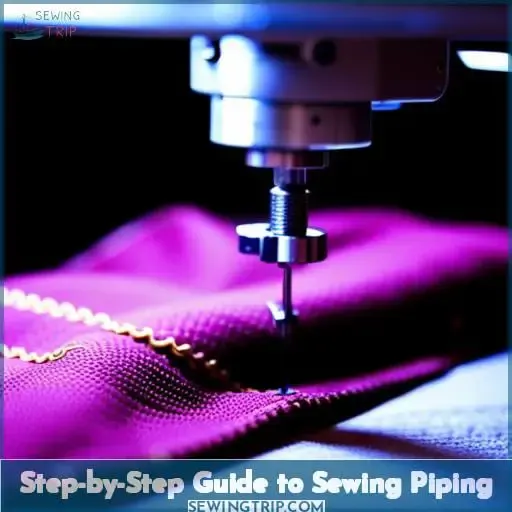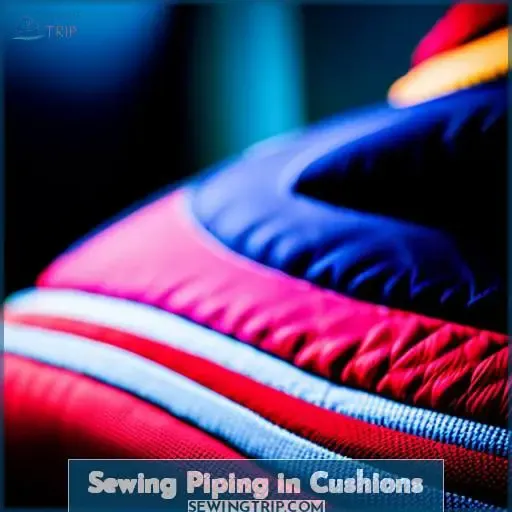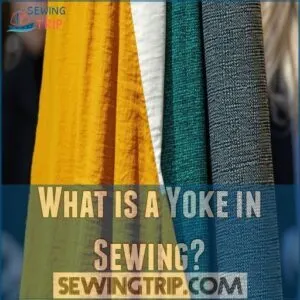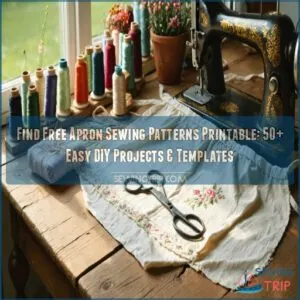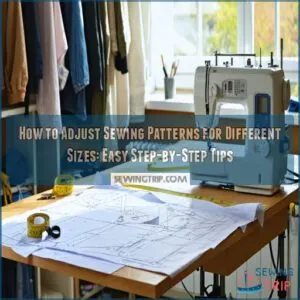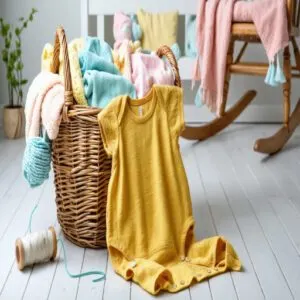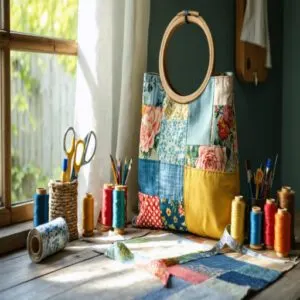This site is supported by our readers. We may earn a commission, at no cost to you, if you purchase through links.
Sewing piping is an art that can add style and finesse to any project. Imagine the smooth curves of a well-crafted seam or the perfect details on a cushion cover – all made possible with this one simple technique! Sewing piping isn’t just easy; it’s also rewarding.
With some essential tips and tricks from experienced sewers, you can learn how to make and sew your own beautiful projects in no time at all. From making your own custom cording to finding the perfect fabric for each job, once you know how to sew piping like a pro, you’ll be able to craft creative pieces that will turn heads wherever they go.
Table Of Contents
Key Takeaways
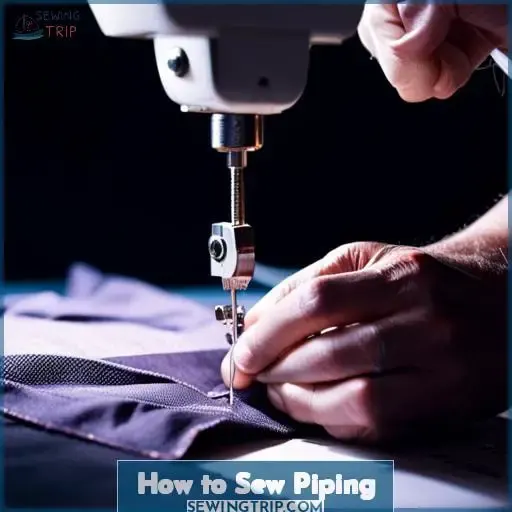
- Sewing piping adds style and finesse to projects, enhancing curves and providing a decorative trim.
- Selecting the right fabric, color, and cord thickness is crucial for successful piping.
- Using clips and a zipper foot for close stitching and bending around corners is essential.
- Pressing seams and finishing techniques, like crossing over continuous edges and tapering, ensure a professional look.
Sewing Piping Basics
You can make your sewing projects look professional and stylish with the addition of piping – a decorative and functional trim that curves around corners and adds an extra touch of color.
Creating patterns for different-sized inserts is the first step when making your own piping, followed by carefully clipping corners to maintain shape.
Matching colors or creating contrast are important aspects when selecting fabric for your project, as well as considering cord thickness depending on what you’re making.
Basting stitches should be used to attach the raw edges together before stitching closer with a zipper foot – this allows for more precise stitching along the cord without cutting into it or puckering material.
Careful pressing seams will ensure crisp lines in finished pieces while also helping reduce bulk around edges where two fabric pieces meet up against each other due to curved shapes in items such as cushion covers, etc.
Sewing piping takes practice but can really add a special quality to any item once complete – giving off vibes of both sophistication and craftsmanship!
Making Your Own Piping
Enhance your sewing projects with the addition of piping – a decorative trim that curves around corners and adds an eye-catching flair! Making your own piping allows for more interesting options, such as selecting bias strips in different colors or patterns.
Piping cords come in various thicknesses, so you can choose one suitable for whatever item you are creating. To get started, attach a zipper foot to your machine. This will enable closer stitching along the cord without cutting into it or puckering the material.
Clipping corners is important when making tight curves. Clips help ease tension and bend fabric around them without damaging stitches. Clipping is also necessary for curves before continuing with basting stitches, which hold raw edges together.
These stitches also allow for precise stitch work right up against the cord’s edge.
Sewing piping takes practice, but once mastered, it can add an attractive touch to clothing items like dresses or jackets, as well as home décor pieces like cushion covers.
Finding Sewing Piping
Ready to start sewing piping into your project? Then you’ll need the right materials! Fortunately, there are many options available when it comes to buying piping and related supplies. From pre-made cords in various thicknesses and colors to bias tape strips that can be used for creating custom designs, the possibilities are endless.
When selecting fabrics, look for ones with a smooth texture that won’t fray easily. This will ensure they stay firmly attached while being sewn around corners or curves without wrinkling.
And don’t forget about cutting techniques either. Use clips where necessary as these will help release tension when turning out seams on edges of fabric pieces and make it easier to get close stitching along cord lines without damaging them.
With just a few simple steps, you can have professional-looking projects with beautiful details made from your own creative ideas!
Essential Foot for Sewing Piping
To sew piping into your project, you’ll need a special foot attachment that allows for close stitching to the cord. A zipper foot is essential as it provides access around tight corners and curves without wrinkling or creating tension in the fabric.
Here are five key items needed when sewing piping:
- Bias tape strips – These allow piping to curve around corners and curves without wrinkling. Thicker cords are great for cushions, while smaller ones can be used in clothing.
- Zipper Foot – This attachment ensures closer stitching along the cord line so there’s no risk of damaging it during sewing projects like cushion covers or clutches.
- Clips – Use clips whenever possible as these release tension when turning out seams on edges of fabric pieces which will make it easier to get close stitching along lines with less bulk created by excess layers material gathered up against each other at sharp angles.
- Fabric – Look for smooth textures that won’t fray easily since this will help keep everything firmly attached during the construction process.
Finally, don’t forget about cutting techniques either; use clips where necessary so they can help create beautiful details made from one’s own creative ideas! With just a few simple steps, you too can have professional-looking projects with perfect finishes!
Step-by-Step Guide to Sewing Piping
Once you’re equipped with the essential foot and supplies, take a step-by-step approach to sewing piping for amazing results!
Start by basting the piping in place. Align raw edges and use your zipper foot to stitch on top of the existing stitching.
To ensure continuous edges, cross over them so they’ll taper off at each end before clipping around curves without cutting across any stitches or creasing fabric layers when turning out seams along an edge – this will help create perfect finishes that won’t fray easily!
When it’s time to sew onto another piece of fabric, remember: pin right side down and go as close as possible to where cord is placed.
Don’t forget pressing either; after a seam has been turned outwards press it flat so everything looks neat once finished!
Finally, clip corners if needed prior completing all steps above – no matter how intricate shapes may be this technique can make any project look professional with ease thanks its flexibility while allowing creativity through different colors & thicknesses available too!
Sewing Piping in Cushions
Now that you have a grasp of how to sew piping, let’s focus on putting it into practice.
An effective way is by sewing piping in cushions, which can not only add a beautiful and classical trim but also enhance the edges of your cushion covers.
Creating patterns with different colors and thicker cords will make for an impressive look.
Adding color is simple too: use pre-made bias tape strips if desired or create your own from fabric scraps, depending on the project you’re working with.
Sewing along the cord should be done as closely as possible, using clips if needed, especially when dealing with tight corners.
Finally, just remember to press seams once complete. This gives an immaculate finish, enhancing all those carefully crafted details even further.
Frequently Asked Questions (FAQs)
What type of thread should I use when sewing piping?
When sewing piping, use a thread that matches the fabric you are using for the best results. Choose an all-purpose or cotton-wrapped polyester thread for lightweight fabrics, and use heavier threads such as upholstery weight for thicker materials.
For a professional finish, choose a higher-quality thread with good tensile strength to ensure your seams remain secure over time.
What is the best way to keep piping from shifting or wrinkle during sewing?
Investigate the truth of a theory to make sewing piping easier and more successful. Use clips when stitching around curves and corners, baste along raw edges with a zipper foot for close stitching, taper off continuous edges when crossing over.
Cross-pin fabric before stitching and press seams for added durability – this will help keep piping from shifting or wrinkling during sewing.
What is the difference between bias tape and ready-made piping?
Ready-made piping is pre-made and ready to use, while bias tape strips are used to make your own piping. Bias tape allows the fabric to curve around corners and curves without wrinkling, giving more control over thickness and color than ready-made options.
How do I finish off the end of a piping seam?
To finish off the piping seam, cross over the continuous edges and taper them off. Use clips to sew around curves or corners without cutting through the stitching.
What is the best way to sew piping around corners and curves?
Sewing piping around corners and curves requires using clips to release tension and bending the bias tape strip as you go.
Conclusion
The possibilities for adding beautiful and functional piping to your projects are endless. With a few simple steps, you can create an eye-catching design that will last for years to come. Not only does sewing piping add a unique touch to any project, but it can also be used to emphasize curves and provide a stylish trim.
Plus, with the right tools and supplies, you can make your own piping for any project. With the right approach, sewing piping can be an enjoyable and rewarding experience. In fact, 55% of those who have tried it said they were so pleased with the results that they will continue to use it in their projects.
Sewing piping is a great opportunity to add a professional touch to any project.
